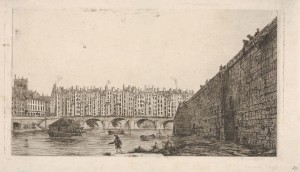
A Bridge to Somewhere
I dare anyone to shout out a name of a major European city that wasn’t founded on or near a major river or waterway. London has the Thames. Budapest has the Danube. Rome has the Tiber. Paris has the Seine.
There are 37 bridges in Paris that cross the Seine. The Pont au Change is only one of them. It connects the Right Bank with the Île de la Cité. There have been numerous bridges on this site and records show that Caesar’s troops destroyed a bridge here in 50 BC.
Napoleon was here!
The current bridge was built between 1858 and 1860 during the reign of Napoleon III (you can see his insignia on the sides of the bridge). However, the previous bridges had been built of wood. Most of the wooden bridges, including the Pont au Change, had wooden structures built on top of the bridge. So any pedestrian crossing over the bridge could not see the river (the Pont Neuf was the first bridge to not have structures built on it—in other words, for the first time, pedestrians could see the river as they traversed the bridge).
The bridge got its name from the moneychangers and gold smiths who set up shop on the bridge during the 12th century. This was an extremely important bridge as it provided direct access to the king’s palace on the Ile de la Cite. It also provided access from the north (along the Rue Saint Denis) where it was thought the most dangerous outside threats would come from. Because of these two issues, a wooden tower was constructed in 870 where the bridge (then called the Grand-Pont) met the Right Bank.
The ‘Les Mis” Connection
Louis VI built the immense stone structure, the Grand Châtelet, in 1130 to replace the wooden tower. The Grand Châtelet became the fortress protecting the entrance to the Île de la Cité as well as becoming the residence of the Prévôt of Paris (provost), a prison, and the administrative offices for the city of Paris. It was demolished after the French Revolution. The Pont au Change is the bridge Inspector Javert threw himself off in Victor Hugo’s novel, Les Misérables. Today, the Place du Châtelet is the location of the old fortress.
Do we have a lot of stories? Of course we do. I’m looking forward to sharing these with you. Please continue to visit our newsletter and blog (www.stewross.com). Perhaps you would like to subscribe so you don’t miss out on the most recent newsletter and blog posts.
Thanks so much for following my little journey through this incredibly interesting process of writing a series of niche historical travel books and then getting the bloody things published.
-Stew
Please note that I do not and will not take compensation from individuals or companies I mention or promote in my blog.
Are you following us on Facebook and Twitter?
Copyright © 2014 Stew Ross

